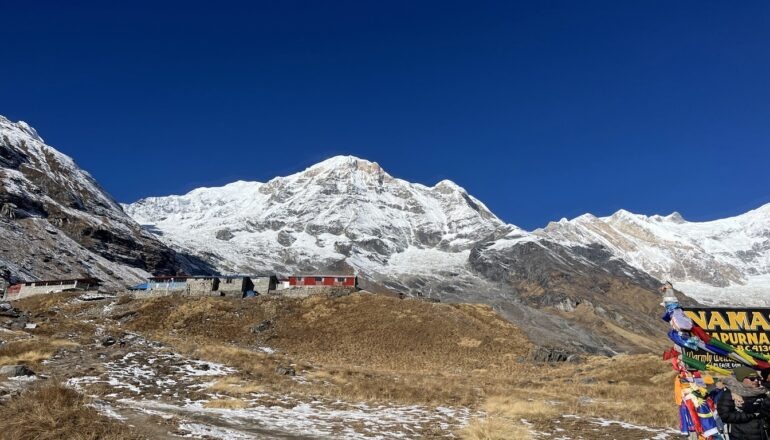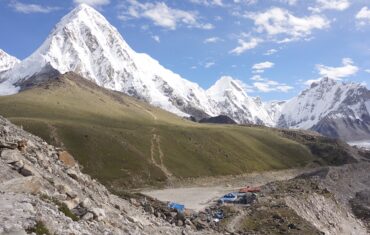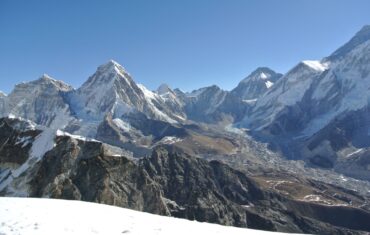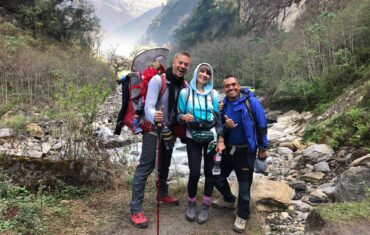Introduction: Annapurna Base Camp
Nestled in the heart of the Annapurna region, the trek to Annapurna Base Camp (ABC) promises a journey into the breathtaking beauty of the Himalayas. Renowned for its diverse landscapes, vibrant cultures, and awe-inspiring mountain views, the Annapurna Base Camp trek is a magnetic pull for trekkers seeking adventure, serenity, and a connection with nature. In this extensive blog post, we embark on a detailed exploration of the Annapurna Base Camp, uncovering the nuances of the trek, the cultural tapestry of the region, and the unparalleled natural wonders that make this destination a must-visit for all trekking enthusiasts.
The Annapurna Base Camp (ABC) trek, often hailed as a pinnacle of Himalayan adventure, transcends the conventional boundaries of trekking. Beyond the majestic peaks and breathtaking landscapes, this journey to the heart of the Annapurna Sanctuary is an odyssey of self-discovery, where every step is an exploration of not just the physical realm but the inner landscapes of the soul. In this blog post, we delve into the unique aspects of the Annapurna Base Camp trek, emphasizing its transformative power and the profound connection it fosters between the trekker and the mystical Himalayas.
Mystical Encounters: Machapuchare and Beyond:
The ethereal silhouette of Machapuchare, or Fishtail Mountain, guards the gateway to the Annapurna Sanctuary like a silent sentinel. Considered sacred and unclimbed, Machapuchare exudes an aura of mystery and reverence. As trekkers move deeper into the sanctuary, the towering peaks of Annapurna I and Annapurna South reveal themselves, creating a backdrop that transcends mere physical beauty. This is a place where the mountains are not just geological formations but living entities, each with its own story to tell.
Nature as a Teacher:
From the verdant foothills to the rugged alpine terrain and the glacial basin of Annapurna Sanctuary, the trek to ABC serves as a classroom where nature imparts invaluable lessons. The rhythmic cadence of footsteps on the trail becomes a meditation, a conversation with the earth itself. Trekkers find solace in the symphony of rustling leaves, the gushing of mountain streams, and the call of exotic birds echoing through the Himalayan valleys. In these moments of communion with nature, the external world fades, and the internal journey begins.
Cultural Immersion:
While the landscapes are a canvas of natural wonders, the cultural tapestry of the Annapurna region is equally captivating. Gurung and Magar villages along the trail offer a glimpse into a way of life shaped by the mountains. Trekkers have the opportunity to share in the warmth of traditional tea houses, where stories are exchanged over cups of steaming chai, and local delicacies provide a taste of Himalayan hospitality. The blending of nature and culture fosters a sense of interconnectedness that resonates with those who tread this sacred path.
The Inner Journey: Reflection and Contemplation:
As trekkers ascend through the varied terrains, the Annapurna Base Camp trek becomes a metaphorical ascent into the inner realms of the self. The physical challenges of the trail mirror the emotional and mental obstacles encountered in everyday life. With each step, trekkers confront their limitations, embrace resilience, and discover an inner strength that may have remained dormant in the routine of daily existence. The panoramic views from the base camp provide not just a visual spectacle but a canvas for self-reflection and contemplation.
Sunrise Over Annapurna: A Soul-Stirring Experience:
The dawn at Annapurna Base Camp is a moment of unparalleled magic. As the first rays of sunlight kiss the snow-capped peaks, the entire sanctuary is bathed in a warm golden glow. This sunrise is not just a visual feast; it’s a spiritual awakening. The mountains, the sky, and the trekker become one in a fleeting moment of transcendence, an experience that lingers in the memory long after the trek is completed.
Preserving the Sacred Connection:
The transformative power of the Annapurna Base Camp trek comes with a responsibility to preserve the sanctity of this sacred connection. Trekkers are encouraged to tread lightly, respecting the delicate ecosystem and cultural heritage of the region. Responsible tourism practices, support for local initiatives, and a commitment to environmental conservation ensure that future generations can continue to embark on this transformative journey.
Annapurna Region: A Tapestry of Nature’s Grandeur:
The Annapurna region, part of the larger Annapurna Conservation Area, boasts a stunning array of landscapes ranging from subtropical forests and terraced fields to alpine meadows and high-altitude deserts. This diversity makes the Annapurna Base Camp trek a captivating odyssey that takes trekkers through a symphony of natural wonders, each day offering a new spectacle to marvel at. The Annapurna Massif, dominated by the majestic Annapurna I (8,091 meters), creates a dramatic backdrop that evolves as trekkers ascend towards the base camp.
Trekking to Annapurna Base Camp:
The trek to Annapurna Base Camp typically begins in Nayapul, and the trail winds its way through charming villages like Ghandruk and Chhomrong. As trekkers ascend, the landscapes transform from lush forests of rhododendron and bamboo to alpine meadows adorned with vibrant wildflowers. The teahouse accommodations along the way provide a cozy respite for trekkers, offering a glimpse into the warm hospitality of the local Gurung and Magar communities.
The Sanctuary: A Natural Amphitheater:
Annapurna Base Camp, often referred to as the Annapurna Sanctuary, is a high glacial basin surrounded by towering peaks, including Annapurna I, Annapurna South, Hiunchuli, and Machapuchare (Fishtail). The trek culminates in this natural amphitheater at an altitude of 4,130 meters (13,550 feet), providing trekkers with a panoramic view of some of the world’s highest and most iconic peaks. The sheer grandeur of the mountains reflected in the glacial basin creates a surreal ambiance, making the journey to the base camp an experience that transcends the physical realm.
Cultural Richness of the Annapurna Region:
The trek to Annapurna Base Camp is not just a communion with nature; it is also an exploration of the rich cultural tapestry of the region. Villages along the trail showcase traditional Gurung and Magar architecture, with intricately carved wooden windows and stone-paved paths. Trekkers have the opportunity to participate in local festivals, witness traditional dances, and visit ancient monasteries, adding a cultural dimension to the trek that enhances the overall experience.
Trekkers traverse steep ascents and descents, encounter high-altitude conditions, and face unpredictable weather. However, the challenges are generously rewarded with the ever-changing landscapes, cultural encounters, and the sense of accomplishment that comes with reaching the base camp and standing amidst the giants of the Himalayas.
Conservation and Responsible Tourism:
As the popularity of the Annapurna Base Camp trek grows, so does the importance of responsible tourism and conservation efforts. The Annapurna Conservation Area Project (ACAP) has been instrumental in preserving the natural and cultural heritage of the region. Trekkers are encouraged to adhere to sustainable practices, support local initiatives, and contribute to the conservation of the pristine environment that makes the Annapurna Base Camp trek so extraordinary.
Inclusions for an Annapurna Base Camp trek package often vary among trekking agencies, but typical inclusions are:
Inclusions:
* Airport Transfers: Arrival and departure transfers between the airport and hotel in Kathmandu.
* Accommodation: Accommodation in Kathmandu and Pokhara (usually on a twin-sharing basis) in tourist-standard hotels. During the trek, accommodation is provided in tea houses or lodges along the route.
* Meals: Meals are usually provided at tea houses along the trekking route.
* Trekking Permits: Necessary trekking permits, such as the Annapurna Conservation Area Permit (ACAP) and Trekkers’ Information Management System (TIMS) card.
* Transportation: Ground transportation between Kathmandu and the trek starting/ending point, often by private vehicle or tourist bus.
* Guides and Porters: Experienced trekking guides who are familiar with the route and local conditions, as well as porters to carry a portion of the trekker’s load.
* Welcome and Farewell Dinners: Welcome and farewell dinners in Kathmandu.
Exclusions:
* International Flights: The cost of international flights to and from Kathmandu.
* Travel Insurance: Trekking insurance covering medical expenses, emergency evacuation, and trip cancellation.
* Nepal Visa: The cost of obtaining a visa for Nepal upon arrival at the airport.
* Personal Expenses: Expenses of a personal nature, including snacks, beverages, and items of a personal nature.
* Tipping: Tips for guides and porters are not always included and are usually at the discretion of the trekker.
* Additional Costs: Additional costs for services not mentioned in the inclusions.
It’s crucial to carefully review the inclusions and exclusions provided by the trekking agency you choose to ensure you have a clear understanding of what is covered and what you need to arrange independently.
Itinerary
Day 1: Kathmandu Arrival
* Meet with your trekking guide for a briefing about the trek.
Day 2: Nayapul Drive and Tikhedhunga Trek
* Start trekking to Tikhedhunga (1,480m).
Day 3: Chhomrong to Bamboo
* Trek from Chhomrong to Bamboo (2,310m).
* Pass through Dovan and Himalaya villages.
Day 4: From Deurali to ABC
* Enjoy spectacular views of the Annapurna range.
Day 5: ABC to Bamboo
* Trek from ABC to Bamboo, retracing the same trail.
* Relax in the natural hot springs near the river.
Day 6: Jhinu Danda to Nayapul, Drive to Pokhara
* Trek from Jhinu Danda to Nayapul.
* Drive to Pokhara, a beautiful lakeside city.
Day 7: Departure
* Depart from Kathmandu or extend your stay to explore more.
It’s advisable to check the latest information and weather conditions before planning your trek.
Equipments Needed
When preparing for the Annapurna Base Camp trek, it’s essential to pack the right equipment to ensure your safety and comfort during the journey.
Clothing:
* Lightweight trekking pants
* Trekking shorts
* Long-sleeved shirts
* T-shirts
* Fleece jacket or pullover
* Insulated jacket (down or synthetic)
* Waterproof and windproof pants
* Thermal underwear
* Moisture-wicking socks
* Warm gloves
* Hat or beanie
Footwear:
13. Hiking boots (broken in and waterproof)
* Camp shoes or sandals
Trekking Gear:
15. Backpack (daypack for daily essentials)
* Sleeping bag suitable for cold temperatures
* Trekking poles
* Headlamp with extra batteries
* Sunglasses with UV protection
* Water bottles or hydration system
* Snacks (energy bars, nuts, dried fruits)
Personal Items:
* Quick-drying towel
* Sunscreen and lip balm
* Personal medications and a basic first aid kit
* Wet wipes or hand sanitizer
* Insect repellent
Miscellaneous:
28. Trekking map and guidebook
* Camera with extra batteries
* Power bank
* Plastic bags (for waterproofing items)
* Money (in local currency)
* Duffle bag or backpack for porters (if applicable)
Documents:
34. Passport with Nepal visa
* Trekkers’ Information Management System (TIMS) card
* Annapurna Conservation Area Permit (ACAP)
* Travel insurance details
It’s crucial to consider the season and weather conditions during your trek and adjust your clothing and gear accordingly. It’s also a good idea to check with your trekking agency for any specific recommendations or requirements. Additionally, pack light but efficiently, as you’ll be carrying your own daypack during the trek.
Dos:
Acquire Necessary Permits:
Stay Hydrated:
Follow the Trekking Itinerary:
Stick to your planned itinerary to ensure a gradual acclimatization process and reduce the risk of altitude sickness.
Greet locals with a “Namaste” and be mindful of their traditions.
Pack Wisely:
Pack essentials, but keep your backpack light. Carry the necessary clothing, gear, and personal items.
Dispose of waste responsibly and follow the principles of “Leave No Trace.” Carry out all non-biodegradable items.
Stay Connected:
Bring layers and be prepared for varying conditions, including rain, wind, and cold temperatures.
Train and Prepare:
Engage in physical training before the trek to build stamina and endurance. Follow
Be aware of potential hazards and stay on designated paths.
Don’ts:
Don’t Rush Acclimatization:
Avoid ascending too quickly. Take the time to acclimatize properly to reduce the risk of altitude sickness.
Don’t Litter:
Do not litter along the trail. Carry your trash and dispose of it properly in designated bins.
Don’t Ignore Altitude Symptoms:
Take altitude sickness symptoms seriously. If you experience symptoms like headaches, nausea, or dizziness, inform your guide and consider descending.
Don’t Stray from Designated Trails:
Straying off the path can disturb the ecosystem and pose safety risks.
Don’t Forget Sun Protection:
Avoid neglecting sun protection. Use sunscreen, wear sunglasses, and protect yourself from the sun’s strong rays, especially at higher altitudes.
Don’t Consume Untreated Water:
Avoid disrespectful behavior or actions that may offend local communities. Seek guidance from your guide regarding cultural sensitivities.
Don’t Overpack:
While it’s essential to be prepared, don’t overpack unnecessary items. Keep your backpack manageable.
Don’t Hesitate to Ask for Help:
If you encounter difficulties or health issues, don’t hesitate to seek assistance from your guide or fellow trekkers.
Following these dos and don’ts will contribute to a safer, more enjoyable trekking experience in the Annapurna region.
Conclusion:
The Annapurna Base Camp trek is more than a physical expedition; it is an odyssey of self-discovery, a pilgrimage to the inner sanctum of the soul. With each step, trekkers move beyond the tangible landscapes into the realm of the intangible – where nature, culture, and the self converge in a harmonious symphony. Annapurna Base Camp beckons not just to those seeking adventure but to those on a quest for self-realization, inviting them to explore the depths of their being amidst the grandeur of the Himalayas. So, lace up your boots, embrace the mystery, and let the journey to Annapurna Base Camp be the gateway to a transformative adventure that extends beyond the summit and into the very core of your being.
For More Information you can visit this link https://www.actual-adventure.com/
Annapurna Base Camp beckons to those who seek a harmonious blend of adventure, natural beauty, and cultural immersion. The trek unfolds like a symphony, with each step revealing a new note in the melody of the Himalayas. From the lush valleys and terraced fields to the high-altitude desert and glacial basin, the landscapes captivate the senses and leave an indelible mark on the soul. The Annapurna Base Camp trek is an odyssey that invites trekkers to witness the grandeur of nature, connect with local communities, and experience the thrill of standing in the shadow of some of the world’s highest peaks. So, lace up your boots, pack your sense of wonder, and embark on a journey to the heart of the Annapurna region, where the mountains meet the sky, and adventure meets tranquility.
You can also check this link for more Information.
Book Now Annapurna Base Camp Trek









